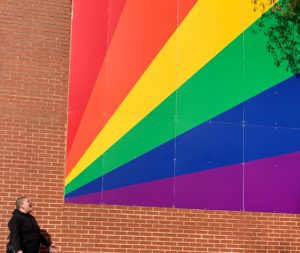By Sierra Voorhies

We have all heard of the LGBTQIA+ acronym representing the queer community (this acronym, the identities it represents, and even more terms are explained here), but you might be surprised to know that sexism affects queer people, those of all genders and sexualities. Sexism in this context is the undermining and devaluing of femininity as well as discrimination against femininity (instead of being narrowed to prejudice and discrimination against cis women from cis men). Unfortunately, sexism affects the queer community in a lot of ways, so this will be the first in a series of posts. The first sexist trend we see through the LGBTQIA+ space is queer feminine of center (foc) people not being nearly as represented in media or stories as masculine of center people are.
Take box office hits “Bohemian Rhapsody” about Freddy Mercury and “Rocketman” about Elton John, for example; are there any movies starring queer feminine of center people being made to the same impact, scale or success? GLADD (Gay and Lesbian Alliance Against Defamation) found that in 2019 within LGBT representation in movies, only 32% of LGBT characters in mainstream media were women, where 68% were men. GLAAD also noted that “there were zero transgender or non-binary characters counted in mainstream releases this year.” An example from Cleo-Symone Scott of how sapphic relationships are less valued is in the Academy Awards, where Brokeback Mountain and Milk were given Best Picture, but lesbian films (for example Battle of the Sexes featuring a lesbian’s historic tennis win over a straight cis man) are rejected by judges. It’s important to note that bisexuals and transgender characters lag behind in proportional representation to their gay and lesbian counterparts.
In the future we will discuss why this imbalance exists and how it’s tied to sexism, but for now let’s address the problem: we need to see queer women as more than the main character’s side kick or the straight man’s eye candy, but how do do that? How do we validate queer foc individuals in their sexualities? Well, of course, we can create and support the representation we want to see. If you are in a story-telling position, advocate and create feminine of center love stories. For us consumers out here, find and engage with queer foc stories by streaming movies, buying books, reviewing or sharing on social media, etc. We can vote with our dollar for the kinds of stories we want to see.
If you’d like to see some foc queer relationships, there is some representation out there: check out the Legend of Korra comics, listen to Haley Kiyoko’s “Girls like Girls,” watch She-Ra and the Princesses of Power, or read Sappho or the people she inspired like Gertrude Stein. There is also information to find online like this article about critically acclaimed Women who Love Women movies and this website that lists books that represent queer relationships.